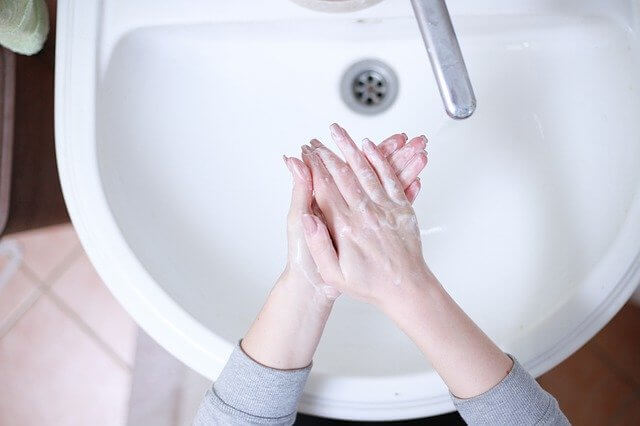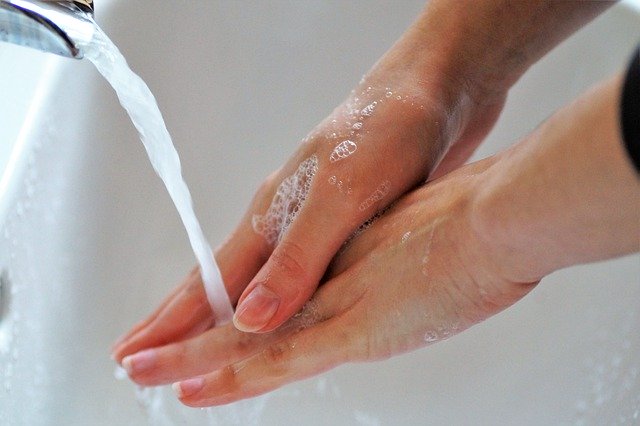lic. rat. med. Jerzy A. Kozłowski
On average, there are 150 different species of bacteria, viruses, and other pathogens on the hands. Hand hygiene is important in preventing the transmission of diseases. This is especially true for medical personnel and those in contact with sick individuals, where hand hygiene is of paramount importance. Hospital infections pose a very serious epidemiological and economic problem worldwide.
Hand Hygiene of Medical Personnel
Hand hygiene and the use of gloves are the cheapest and simplest, yet highly effective methods of preventing hospital and community-acquired infections. Observational studies show a correlation between the level of hand hygiene and the incidence of infections and multi-resistant strains [1].
Ręce należy dezynfekować każdorazowo przed i po kontakcie z pacjentem i jego środowiskiem. Dane Narodowego Programu Ochrony Antybiotyków wskazują, że personel medyczny nie zawsze dba o czystość rąk w należyty sposób [2]. Niekiedy nadużywane jest stosowanie rękawiczek medycznych, których używa się zamiast mycia lub dezynfekcji rąk, a nie jako dodatkowe zabezpieczenia.
Read also When should gloves be worn?
Washing or Disinfection?
Before and after contact with a patient, hands should be disinfected. Hygienic handwashing should be conducted in situations where the staff is finishing a visit, entering the staff room, before meals, after and before using the toilet, or when hands are visibly soiled. In other situations, disinfection should be performed, which is faster and more effective [2].
The use of medical gloves does not exempt from the obligation to maintain hand hygiene. Disinfection should be carried out every time before putting on gloves and after taking them off [2].
Everyday Hand Hygiene — Infection Prevention and Control

Not only medical staff are obliged to maintain skin cleanliness. This applies to everyone, as hand washing and disinfection are the simplest ways to limit the spread of infections, including common ones like colds, flu, or the SARS-CoV‑2 virus, which the world is currently struggling with.
Proper hand washing, along with adhering to other hygiene and preventive measures, significantly reduces the risk of transmitting infections. We unconsciously and instinctively touch our face areas with our hands, which can lead to the entry of viruses and bacteria through the mucous membranes of the mouth and nose.
Guidelines on Hand Hygiene
Indications for hand hygiene include: visible soiling or contamination with body fluids, contact with a patient and their environment, and performing aseptic procedures. Hand washing or disinfection is also performed after removing non-sterile and sterile gloves, before preparing medications, food, after using the toilet, and in all other situations where there is a likelihood of transferring microorganisms [4].

Hand Hygiene Technique Using a Disinfectant Agent
The procedure lasts 20–30 seconds:
1. Apply the disinfectant to the surface of your hands.
2. Rub the disinfectant, spreading it over the inner parts of the hands.
3. Place one hand on the back of the other hand and rub the disinfectant in, then switch sides and do the same.
4. Interlace your fingers with the palms facing each other.
5. Tuck the backs of the fingers into the palm of the other hand, interlocking them, and make several movements.
6. Rotate and rub the thumb of one hand, and then the other.
7. Rotate and rub the inside of your palm with the clenched fingers of the other hand, then switch sides [4].
Hand Hygiene Technique Using Water and Soap
The duration of the hygienic hand washing procedure is 40–60 seconds
1. Dispense soap from the dispenser.
2. Rub your palms together with fingers extended.
3. Place one hand on the back of the other hand, rub the soap in, and then switch sides.
4. Interlace your fingers with palms together and rub.
5. Hook the back of the fingers of one hand against the other, interlocking them, and then make sliding movements.
6. Wash the thumbs with a rotating motion inside a clenched fist.
7. Massage the inside of the palm with clenched fingers [4].
8. Rinse hands under running water.
9. Dry hands with a disposable towel.
10. Do not touch the faucet with your hands, use your elbow or a paper towel to turn off the water.
Medical personnel should have access to effective protective measures, but hand washing and disinfection should not be combined unless there is visible soiling. In the case of contamination and visible dirt, hand washing should be done before disinfection. Rękawice medyczne nie mogą zastępować higieny rąk. Whenever necessary and reasonable, gloves should be used, and after the task is completed, they should be removed and hands disinfected.
The 5 Moments of Hand Hygiene.
When to practice hand hygiene in hospital settings and when in contact with patients is well described by the so-called “5 Moments of Hand Hygiene:
- Before touching a patient – prior to each contact with a patient, it is essential to perform hand hygiene to protect the patient from microorganisms.
- Before clean/aseptic procedures – immediately before performing a medical procedure. Hand disinfection is carried out to protect the patient from harmful microorganisms.
- After body fluid exposure/risk – when you come into contact with any body fluids, perform hand hygiene to protect yourself and the hospital environment after removing gloves.
- After touching a patient – to protect yourself and the hospital environment.
- After touching patient surroundings – as microorganisms are also present there, hand hygiene of medical personnel should include every situation after contact with objects touched by the patient [3].
Bibliography:
1. European Centre for Disease Prevention and Control. Infection prevention and control for COVID-19 in healthcare settings – Fourth update. 3 July 2020. ECDC: Stockholm; 2020;
2. dr n. med. Tomasz Ozorowski, Higiena rąk personelu medycznego w Polsce, portal mp.pl )04.05.2018);
3. Geneva, World Health Organization „Your 5Moments for Hand Hygiene”. May 2009
4. Wytyczne WHO dotyczące higieny rąk w opiece zdrowotnej – podsumowanie” ©World Health Organization 2009 WHO/IER/PSP/2009.07
5. dr med. Jacek Mrukowicz, Higiena rąk, portal mp.pl (06.10.2016)
 Polski
Polski